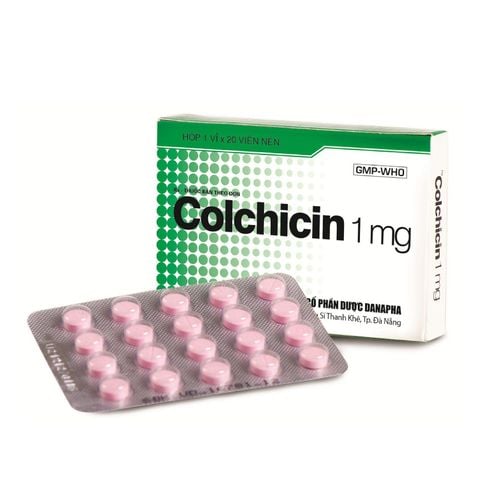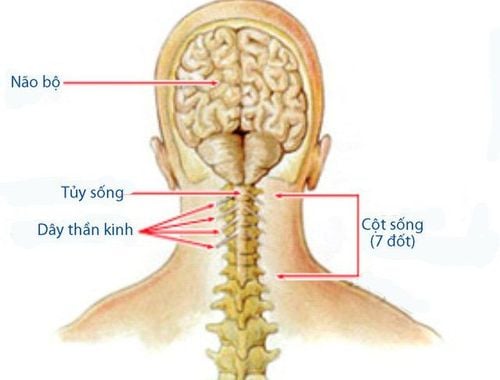This is an automatically translated article.
The article was written by Orthopedic Doctor - Department of General Surgery - Vinmec Central Park International General HospitalDegenerative cervical myelopathy is common in the elderly (usually over 55 years old), characterized by cervical spinal cord compression due to bone spurs, disc herniation, and yellow ligament hypertrophy. The disease progresses slowly with symptoms of stiff neck, arm pain, hand numbness, and gradual weakness of the extremities.
1. What is cervical myelopathy?
Neck pathology occurs as a result of compression of spinal cord - cervical root by many different causes such as: degeneration, trauma, ossification, disc herniation, tumor, inflammation... usually caused by cervical spondylosis is common.
Cervical spondylosis refers to degenerative changes, including degeneration of the trochanter, discs, ligaments and connective tissues of the vertebrae. Three important factors in pathophysiology include: Static mechanism, dynamic mechanism, and spinal ischemia.
1.1 Static Mechanism Static mechanism causes spinal canal diameter reduction and spinal cord compression. The discs become dehydrated, dry, and decrease in height with age. This process further damages the articular cartilage and the corresponding cartilage plate. Degenerative bony spurs develop from the margin of this cartilaginous plate along with disc calcification to enhance spinal stability. When the bone spurs overgrow, the yellow ligaments become stiffer, bulge into the spinal canal, they directly compress and cause cervical myelopathy (usually causing symptoms when the spinal canal size is reduced by at least 30%).
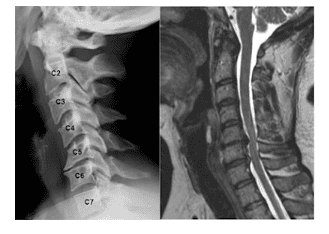
X quang cột sống cổ
1.2 Dynamic Mechanisms The dynamics of normal cervical spine movements aggravate existing spinal cord injuries. When the neck is bent, the spinal cord is stretched and rubbed against the bone spurs; When the neck is tilted back, the yellow ligament bulges and pushes against the spinal canal, narrowing the already narrow spinal canal.
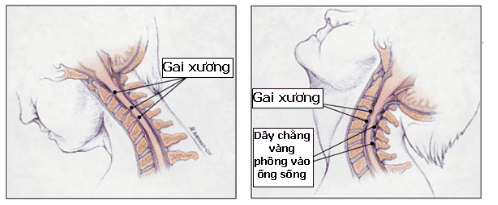
Cơ chế động của cột sống cổ
1.3 Mechanism of ischemia The ischemic mechanism probably also plays a role in cervical myelopathy, especially in the late stages. Histological changes are consistent with marrow ischemia, but the exact mechanism is unknown.
Other factors are also related to spondylolisthesis such as: Heavy labor, posture and genetic factors. About 70% of people with Down syndrome have spondylolisthesis by the age of 50.
2. Symptoms of cervical myelopathy due to degeneration
Patients with cervical myelopathy often have stiff neck, deep pain on one or both sides of the neck, spreading to the shoulder, arm, and stiff and clumsy gait (Robot gait). The disease usually progresses slowly, in the early stages, the patient often feels stiff neck, some patients have a crackling sound when moving the neck. Arm pain, characterized by sharp pain along the axis of the arm, elbow, wrist, or fingers. The patient feels a dull pain in the arm, numbness or tingling in the hand. The patient has hand muscle atrophy, loss of sensation, increased reflexes. When bending the patient's neck, there will be an electric shock-like sensation down the middle of the back (Lhermitte's sign).
3. Diagnosis of cervical myelopathy
3.1 Physical examination Examination of signs: Signs of hand muscle atrophy may be detected. Patients may lose vibrating sensation, somatic sensation, especially in the feet.
3.2 Routine Radiological Imaging: Initial Preliminary Evaluation.
Computed tomography (CT scanner): Assesses the bone better than MRI. Possibly ossification of the posterior longitudinal ligament compresses the pulp.
Magnetic resonance (MRI) : Helps evaluate the degree of spinal stenosis, spinal cord compression; detect intramedullary lesions such as tumours... An increase in pulp signal intensity suggests myelomalacia or permanent pulpal damage.
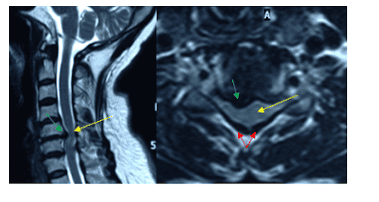
Hình ảnh cộng hưởng từ (MRI) đánh giá mức độ hẹp ống sống
4. Treatment of cervical myelopathy
Evaluation of treatment results for chronic cervical myelopathy due to degeneration is difficult, because without treatment, about 18% of patients recover on their own, 40% of patients are stable, without further progression, and about 40% of patients will get worse. Most, treatment of cervical myelopathy is conservative treatment, a few do not respond to conservative treatment, then consider surgery.
4.1 Conservative treatment Partial rest mode: avoid movements that aggravate the disease, increase bed rest when pain is severe. Immobilize the cervical spine with a neck brace (neck brace) in a physiological position. Non-steroidal anti-inflammatory drugs. Sometimes using corticosteroids, muscle relaxants, vitamin B group Physiotherapy. Conservative treatment is useful in the early stages of the disease
4.2 Surgery When cervical myelopathy is real, surgical intervention is necessary. The goal is to decompress the spinal cord to widen the spinal canal.
4.2.1 Method of cutting the back version of life
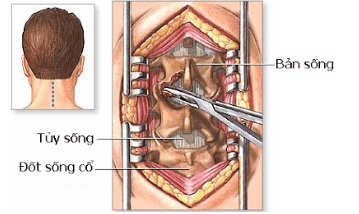
Phương pháp cắt bản sống lối sau
Posterior plasty is a method of extending the spinal canal posteriorly by opening the vertebral plate, there are many types of openings such as: Z-shaped opening (Z - plasty), or opening according to the method of Master Vo Van Thanh (opening to the side, VVT surgery), posterior plasty by Tateru Shiraishi method ...

Phẫu thuật tạo hình bản sống lối sau (làm rộng ống sống)
4.2.2 Anterior decompression surgery Anterior decompression surgery helps to directly remove bone spurs and herniated discs compressing the marrow, bone grafting. In some cases, going to the placement of a bone-welding screw brace helps to prevent instability of the cervical spine after surgery.
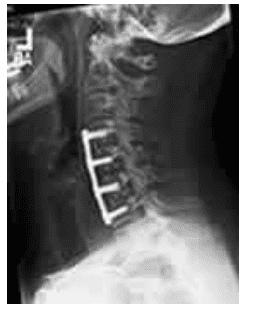
Phẫu thuật giải ép và đặt dụng cụ hàn xương lối trước
Choosing an anterior or posterior incision depends on many factors, but the primary goal is to widen the spinal canal sufficiently to decompress the pulp. And before surgery, non-degenerative cervical myelopathy must be excluded such as multiple sclerosis, amyotrophic lateral sclerosis.
Many factors predict poor surgical outcome, including: Preoperative severe motor paralysis, abnormal signal changes in the spinal cord and/or spinal atrophy seen on MRI, and severe spinal cord compression on imaging learn.
Cervical myelopathy is common in elderly people. Because spondylolisthesis is also commonly seen in many older patients, it is important to correlate the clinical course and the imaging findings. In which, magnetic resonance plays the most important role, showing the number of narrowing floors and excluding other diseases. Treatment, there is still much debate between conservative treatment and surgery. Surgical decompression remains the most appropriate modality for many patients with degenerative cervical myelopathy.
Vinmec International General Hospital is one of the hospitals that not only ensures professional quality with a team of leading medical doctors, modern equipment and technology, but also stands out for its examination and consultation services. comprehensive and professional medical consultation and treatment; civilized, polite, safe and sterile medical examination and treatment space. Customers when choosing to perform tests and treat diseases here can be completely assured of the accuracy and high efficiency in the treatment process.
Please dial HOTLINE for more information or register for an appointment HERE. Download MyVinmec app to make appointments faster and to manage your bookings easily.
SEE MORE
Rehabilitation of cervical spinal cord injury Cervical spine mobility exercises Rehabilitation for patients with spina bifida






